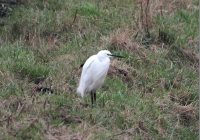Dr Phil Smith’s Wildlife Notes
January 2018
With 18 rain-days and the two named storms Eleanor and Georgina, January was wetter than average. This meant a welcome recovery in the dune water-table which returned to “normal” winter levels. I measured a rise of about 17cm at the Devil’s Hole blowout during the month, resulting in extensive flooding of the lower sections. This is good news for the Natterjack Toad which might have somewhere to breed in the spring.
Big tides and high winds early in the month created a storm surge which, although not as strong as those in the 2013/14 winter, produced some erosion at Formby Point and Hightown. I estimated a 5m loss of dunes at Hightown, impacting important populations of Isle of Man Cabbage and the rare Triple-hybrid Evening Primrose. In contrast, there were minimal effects at the Ainsdale end of Birkdale Green Beach, where the much wider shore absorbs the energy of the waves.
It was not particularly cold, so Snowdrops began to flower in the third week of January. More surprising but welcome was the appearance of Primrose and Corsican Hellebore flowers near Lifeboat Road on 23rd and I heard a Song Thrush singing on 29th. Not bad for mid-winter.
Pink-footed Geese remained in the area in large numbers, justifying several trips to the local mosses. On 8th, about 1500 Pinkfeet on Downholland Moss included an adult Russian Whitefront whose distinctive belly-bar pattern tied in with one photographed earlier at Hightown and Altcar by Peter Kinsella, illustrating the mobility of these birds. I tried again the following day but the geese had gone, to be replaced by a lonely-looking Little Egret. Next day on Altcar Moss, I was overwhelmed by the sight and sound of perhaps the largest single goose flock I have seen in nearly 50 years. There were between 8000 and10,000 Pinkfeet on a large potato field. Parking next to a gap in a hedge I watched entranced as hundreds walked to within 50m of me, tucking into rotting potatoes and making a constant low murmur interspersed with the usual high-pitched “wink, wink”. Ironically, news came through the next day that an energy company had applied for permission to carry out preliminary boring to explore the potential for fracking on the same site.
At Sands Lake, Ainsdale on 27th I was surprised to find, as well as the usual Tufted Ducks, Mallards and Shovelers, three smart male Goosanders. I can’t remember seeing this species here before. These large saw-billed ducks are fish-eaters and they were clearly finding enough food to keep them happy. Unfortunately, an incident with two aggressive dogs and their even more aggressive owner rather took the gloss off the occasion.
Over the last year or so I have started to learn and record mosses and liverworts (bryophytes), an important part of our duneland flora. They are much harder than the higher plants but I am slowly getting there with the help of enthusiastic botanist Joshua Styles. We have already found several new species for the Sefton Coast, one being the inconspicuous liverwort, Bluish Veilwort (Metzgeria fruticulosa). The first South Lancashire record was as recently as 1996 but it has increased enormously and is now widespread and common inland, growing on tree bark. However, this liverwort hadn’t been seen on the coast until we found it last year. Now I seem to be bumping into it everywhere, mainly on old poplars and Sycamore.
Another group that can sometimes be found in the winter is the fungi. A significant discovery by Sol Photiou was Poplar Bells (Schizophyllum amplum), a fungus that only grows on the dead twigs of native Black Poplar. Having asked me for localities of Black Poplars on the dunes, Sol found specimens of the fungus in two places at Formby Point. These are new sightings for the Sefton Coast of a rare species with only 34 UK records, the nearest being in Liverpool.
Less welcome was a pair of Pheasants that has tried to take up residence in my garden, gobbling all the food I put out for the smaller native species. I had the same problem last year, the loud displays of the male in spring waking me up at the crack of dawn. This time I am actively chasing them away and the visits are reducing in frequency. Pheasants are thought to have been introduced from Asia by the Romans but are now bred and released in huge numbers for shooting, perhaps as many as 50 million annually. Estimates suggest that only about 15 million are shot, so it is not surprising that the countryside is infested with Pheasants and they are increasingly invading suburban gardens. These large birds are voracious predators and are known to eat amphibians, reptiles and large insects, possibly adding further pressure to groups that are already declining nationally.




